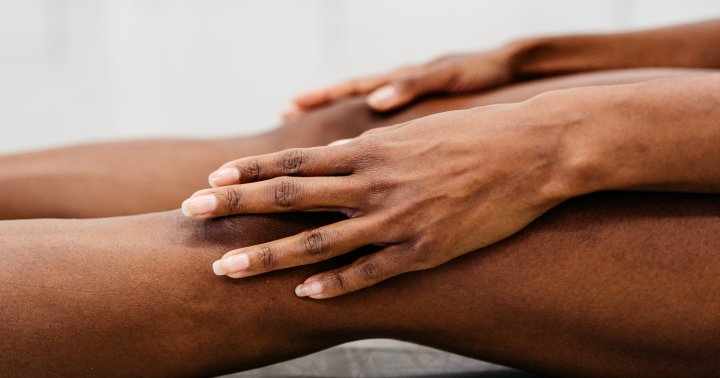This Meditative Practice Might Be The Secret To More Orgasmic Sex
Orgasmic meditation intertwines mindfulness with intimacy and sexuality.


Our editors have independently chosen the products listed on this page. If you purchase something mentioned in this article, we may earn a small commission.
Meditation is the act of turning your attention inward and accepting the present moment. With orgasmic meditation, you can incorporate your sexuality and heighten your usual meditation practice. The sensual system intertwines mindfulness with intimacy and eroticism.
What is orgasmic meditation?
Orgasmic meditation, also known as OM, is a mindfulness and presence practice with an emphasis on pleasure. "OM traditionally focuses on rubbing the upper left quadrant of the clitoris for 15 minutes with a lubricated finger," Holly Richmond, Ph.D., somatic psychotherapist and author of Reclaiming Pleasure, tells mbg. Through this act, you're invited to listen to your body and give in to the extended feelings that arise during the genital stimulation–without the goal of climaxing.
The practice of orgasmic meditation can offer many potential benefits, but it also has a somewhat controversial history. Founded in 2004, OM was popularized by a company called OneTaste, which trademarked a sequenced clitoral stimulation procedure for their workshops. Around 2009, the company gained massive media attention and many followers—before an FBI investigation sent it crashing down. The defunct organization is now facing accusations of sex trafficking, labor law violations, and cult-like business operations. (Note: The experts interviewed for this story are not affiliated with OneTaste.)
All that said, the practice of OM can and should be divorced from the contentious company. As an independent practice, there are still many benefits one can gain from practicing OM in a safe, consensual space. Indeed, in a 2021 study, researchers found that OM induced intense emotions of positivity, heightened partner connection, and significant brain activity in areas linked to oneness, self-transcendence, surrender, and spirituality.
How meditation and sex work together.
In general, meditation is linked with higher sexual satisfaction due to the way it hones your ability to be mindful of your sensations. By zeroing in to your bodily senses and calming the overactive mind, you fully feel everything in the moment, which can lead to more satisfying sexual experiences. A 2019 study noted that being aware in the present moment during sex with your partner can also promote more intimacy and emotional regulation, which can directly enhance the sexual and romantic relationship.
In meditation, there's also an art in letting go completely and detaching from an outcome, which can be a beneficial mindset to bring into sex. "With OM, you are focused on an internal practice and being grounded in your breath and energy rather than the physical touch," psychotherapist and sex therapist Melinda DeSeta, LMHC, says. The idea is to "focus on your breath and keep your mind calm and focused on the pleasure."
By centering stillness, pleasure is no longer a formulaic transaction but an experience to be slowly felt and self-expressed.
How orgasmic meditation is different from regular meditation.
Meditation welcomes all of your thoughts and bodily sensations as you focus on the awareness of your breath. OM works similarly, but the primary focus is on sexual awareness and appreciating the gentle, pulsing waves of pleasure radiating from your genitals. The hands-on method serves as a conduit to therapeutically connect you with the pure state of your emotions without a value judgment.
According to Richmond, OM isn't seen as a regular practice like traditional meditation or caring for your mental and physical health, although it should be. "Sexual health still hasn't gotten to a place where it's being prioritized on a daily basis," she says. This speaks to the prioritization of sexual wellness, which is usually seen as an option and at the bottom of the list for most people.
Benefits of orgasmic meditation.
If you're not sure about trying OM, here's a list of potential perks the practice offers:
1. Masturbation can support your health.
Masturbating is good for your health and can improve mood, sleep, self-esteem, relaxation, and immune system functioning, Richmond explains, as well as releasing sexual tension. A recent 2019 study also noted that engaging in sexual pleasure delivers a rush of chemical benefits, like serotonin and dopamine, to the brain's reward center, which positively correlates to your mood. And besides all of the feel-good chemicals, it just feels good to explore yourself in areas with highly sensitive nerve endings.
2. It elevates female pleasure.
For women especially, their relationship to sexuality can be complex, with pleasure often being viewed as a burden. By participating in OM, it offers another perspective: There are people out there that are turned on by making their partners feel good. "Wrap your head around that," Richmond says. "Your partner is not judging your body or thinking you're taking too long. You deserve the pleasure, and they want to give it to you."
On a more practical note, women take an average of 20 minutes to reach full arousal. "OM dials that back and takes 15 minutes to tune into that arousal," Richmond says.
3. You feel more present.
Porn and pop culture often describe sex as a series of frenetic, rushed steps designed to reach penetration. You could get in your head about doing things a certain way instead of surrendering to the experience itself. By learning how to be mindful of your body as you're being stimulated, you let go of that goal and deeply reconnect to the physical sensations of your body. "The health benefits of meditation are well researched, and with OM, it allows you to stay in the moment instead of living in the past or projecting into the future," Richmond says.
4. Awareness of your body heightens pleasure.
OM facilitates a closer connection to your body and removes disconnection. According to sex educator Suzannah Weiss, as you notice these pleasurable sensations, the pleasure grows. "You begin to notice little things, like how your vaginal muscles contract when you stroke your clit or how your leg shakes when you're feeling intense pleasure."
5. You learn more about your body without shame.
Society is changing and becoming more sex-positive, but intimacy and sexuality can still be a touchy subject. When your body is viewed as taboo, embarrassing, or provocative, the feelings that come with it can be framed in shame. Richmond notes experimenting with OM helps you facilitate a present relationship with your body and communicate ways you can receive pleasure. Appreciating your body also breaks down any walls you might have built around sex and helps release those harmful, internalized messages.
6. It strengthens the bond with your partner.
DeSeta explains that OM takes out the physical nature of sex so you can connect to your partner intimately and mentally. Sexual satisfaction then evolves into a multidimensional exercise of vulnerability. Plus, sex feels better once you know exactly what your partner likes. "OM is a great tool in helping people build a positive relationship with touch and pleasure," she says.
"OM can help females overcome sexual challenges, sexual pain, previous trauma, and learn how to connect their mind and body with intimate pleasure," DeSeta says. Adding on to that, Richmond notes it can be difficult for survivors of sexual trauma to be in their body. Through incorporating OM, it can help your body safely process the trauma somatically. "OM can help with embodiment where you're not feeling dissociated," Richmond says.
To begin, apply lube to a finger. "If a partner is doing it, they'll put a hand underneath your butt and a thumb partially inside the vagina. With the other hand, they'll lift up the clitoral hood and stroke the clitoris directly, particularly on the upper left quadrant," Weiss says.
This upper left quadrant area is supposedly the most sensitive part, though it varies from person to person, and there isn't research proving this. "If you're doing it by yourself, you only need to worry about lifting up the hood and stroking the clit, either with one hand or both. Sometimes, it helps to hold a hand mirror in the other hand to see what you're doing."
Weiss notes if you're strictly sticking to the structure of OM, there's 13 minutes of clitoral stroking and then two minutes of the partner applying "grounding pressure" to the vulva with their hands.
Weiss herself teaches a looser version of OM based on the extended orgasm or deliberate embodied orgasm model. "In extended orgasm or deliberate embodied orgasm, the timing is looser, but people may decide on a time frame, like 20 to 30 minutes or even an hour."
Timing the experience can feel clinical, but she explains many people who teach the practice use the timer to challenge the transactional way we look at sexual reciprocation. Receiving and responding to your partner's touch is a gift, and you don't have to do anything in return if you don't want to, Weiss says. "When you have both agreed that you'll be receiving pleasure for a certain time frame, you don't have to worry about taking too long or reciprocating. For that time, it's all about you."
Varying the stroke and placement.
In the process, Weiss notes the giver should vary their strokes and application of pressure based on the receiver's feedback as the receiver tunes into their body and notices whatever sensations come up. "A lot of people with vulvas have only touched their clitorises over the clitoral hood because often, it mostly or totally covers the clit itself. Touching the clit directly provides a new form of sensation."
Weiss says practitioners of the practice often need to distinguish between what a climax and an orgasm is. A climax feels like a grand finale of a sexual experience, while an orgasm is a pleasurable, high-intensity sensation that may include a climax but doesn't need to involve a "crash" at the end.
"Orgasm is sometimes described as [an] 'activation of the involuntary,' that is, when your body begins experiencing involuntary responses like shaking, sweating, or contracting or pulsing in the pelvic muscles," she explains. "Under this definition, orgasm can go on for minutes or even hours. It's a sensation people can stay present with and savor rather than it starting and ending in a fleeting second."
Weiss says that by seeing an orgasm as a broader range of sensations, it helps some people feel validated and understand that their sexual experiences can be as good, maybe better, than the experiences of people who frequently climax.
For people with penises.
Traditionally, women with clitorises are the ones who receive the stimulation in OM. Weiss notes OM is almost always described in the context of a male "stroker," who provides a "masculine energy," and a female "strokee," who is supposed to "be in her feminine"—but it certainly doesn't have to work this way.
Richmond and Weiss both teach the practice for all bodies, including men and people with penises. "For people with penises, it's slower stroking for 15 minutes with the scrotum," Richmond says. The giver can play around with the speed, stroke pattern, and pressure. (Our lingam massage guide might also be helpful here.)
When you're setting up your space to receive, be mindful of your surroundings so you can feel grounded, relaxed, and safe. Richmond says that could look like cleaning your bedroom, dimming the lights, lighting a candle, or putting on a playlist you enjoy–whatever you're into. "You could do this in the bath or the shower too," she says. There isn't a wrong way to do it.
2. Create a ritualized experience out of it.
"Do you usually have a self-pleasure practice in the morning? Or is it better to practice self-pleasure in the middle of the day or the evening, when you can be focused and present? Be thoughtful about the time of day you want to experiment with it," Richmond recommends. She notes this level of curation can also include adding pillows, being naked or in loose-fitting clothing, and having or not having the covers over you. Thinking about the details in advance helps you focus on the experience when it happens.
3. Start solo at the beginning.
Although OM is traditionally seen as a partnered experience, DeSeta and Richmond suggest starting off on your own to begin. When trying out something new sexually, solo sex is an opportunity to learn about what turns you on without the projections of the other person in the room. (You can reference our guide to tantric masturbation for ideas.) When you're comfortable, involve a partner that you trust.
4. Focus on calming your daily thoughts.
If you are new to meditation in general, it may be useful to learn the basics before jumping into OM. "Start your own daily meditative practice and define what meditation looks like and feels like to you," DeSeta says. As you drop into your body, you'll feel more secure embracing all of the emotions that come up. "OM is more of a practice, and the journey takes time."
When you practice OM, you begin to integrate communication into your sexual practice and find confidence expressing your desires and boundaries, which contributes to a healthy sex life. "OM naturally encourages communication because it encourages partners to talk about what they like, how they give, and how they receive," Richmond says.
6. Prioritize mindfulness over a goal.
"If you go in with the goal of having the best orgasm of your life, it won't happen because there's a lot of pressure on it. Take the performance piece away from it," Richmond advises. "A lot of OM practitioners think it's unfortunate that orgasm is in the title because OM should simply be about mindfulness and giving and receiving pleasure."
Depending on your mental state, meditation will shift with each session. The same goes for OM. It won't look and feel the same way each time. Some days it will be easier to be present, and other days, you might want to rush it along. All experiences are welcome. Instead of forcing along specific desires, detach from the outcome and let your feelings flow in the direction the moment calls for.
8. Consider bringing in toys.
"OM traditionally focuses on finger stimulation of the genitals, but in my practice, I encourage people to start off with hands, then toys, digital stimulation, oral, penis-in-vagina penetration, or anal stimulation," Richmond says. As long as you're incorporating elements that bring you presence without the objective of climaxing, it can add more fun to the mix. Here are some couples' sex toys and clitoral stimulation toys to consider.
As you begin your OM journey, try out the step-by-step framework and then distill it into an individualized process that works for you and/or with your partner. As Weiss puts it, "There are ways to incorporate all those things into your sex life without specifically doing an OM or an extended orgasm session. I encourage people to apply these principles when they're having sex."
If you choose to incorporate an orgasmic meditation practice into your life, it can connect you to your sexual wellness and open up your orgasm, a sensation that already innately exists within you and that you have the right to access.

 Troov
Troov 































